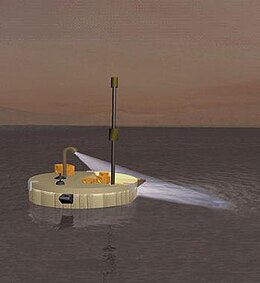Titan Mare Explorer

Artist's impression of TiME lake lander
|
|
| Mission type | Titan lander |
|---|---|
| Operator | NASA |
| Mission duration | 7.5 years Cruise: 7 years; 3–6 months at Titan |
| Spacecraft properties | |
| Power | 140 W |
| Start of mission | |
| Launch date | 2016 (proposed) Not taken beyond proposal |
| Rocket | Atlas V 411 |
| Launch site | Cape Canaveral SLC-41 |
| Contractor | United Launch Alliance |
Titan Mare Explorer (TiME) is a proposed design for a lander for Saturn's moon Titan. TiME is a relatively low-cost, outer-planet mission designed to measure the organic constituents on Titan and would have performed the first nautical exploration of an extraterrestrial sea, analyze its nature and, possibly, observe its shoreline. As a Discovery-class mission it was designed to be cost-capped at US$425 million, not counting launch vehicle funding. It was proposed to NASA in 2009 by Proxemy Research as a scout-like pioneering mission, originally as part of NASA's Discovery Program. The TiME mission design reached the finalist stage during that Discovery mission selection, but was not selected, and despite attempts in the U.S. Senate failed to get earmark funding in 2013.
TiME was one of three Discovery Mission finalists that received US$3 million in May 2011 to develop a detailed concept study. The other two missions were InSight and Comet Hopper. After a review in mid-2012, NASA announced in August 2012 the selection of the InSight mission to Mars.
Missions to land in Titan's lakes or seas were also considered by the Solar System Decadal Survey. Additionally, the flagship Titan Saturn System Mission, which was proposed in 2009 for launch in the 2020s, included a short-lived battery-powered lake lander. Opportunities for launch are transient; the next opportunity is in 2023–2024, the last chance in this generation.
The discovery on 22 July 2006 of lakes and seas in Titan's northern hemisphere confirmed the hypothesis that liquid hydrocarbons exist on it. In addition, previous observations of southern polar storms and new observations of storms in the equatorial region provide evidence of active methane-generating processes, possibly cryovolcanic features from the interior of Titan.
Most of Titan goes centuries without seeing any rain, but precipitation is expected to be much more frequent at the poles.
It is thought that Titan's methane cycle is analogous to Earth's hydrologic cycle, with meteorological working fluid existing as rain, clouds, rivers and lakes. TiME would directly discern the methane cycle of Titan and help understand its similarities and differences to the hydrologic cycle on Earth. If NASA had selected TiME, Ellen Stofan—a member of the Cassini radar team and the current Chief Scientist of NASA—would lead the mission as principal investigator, whereas the Applied Physics Laboratory (APL) would manage the mission.Lockheed Martin would build the TiME capsule, with scientific instruments provided by APL, Goddard Space Flight Center and Malin Space Science Systems.
...
Wikipedia
